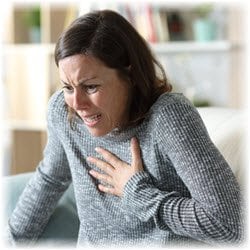Living with Angina Pectoris
 Angina pectoris, also called angina, is chest pain or discomfort that occurs when the heart muscle (myocardium) does not get enough blood (ischemia) and oxygen. “Angina can be a symptom of coronary artery disease (CAD) but it can also have other causes,” says Jessica Weiss DO, PIH Health cardiologist.
Angina pectoris, also called angina, is chest pain or discomfort that occurs when the heart muscle (myocardium) does not get enough blood (ischemia) and oxygen. “Angina can be a symptom of coronary artery disease (CAD) but it can also have other causes,” says Jessica Weiss DO, PIH Health cardiologist.
Most common symptoms of angina include:
- A pressing, squeezing, or crushing pain, usually in the chest under your breastbone
- Pain that may also occur in your upper back, both arms, neck, or ear lobes
- Chest pain that spreads to your arms, shoulders, jaw, neck, or back
- Shortness of breath
- Weakness
- Extreme tiredness (fatigue)
- Feeling faint
Angina chest pain is usually relieved within a few minutes by resting or by taking prescribed cardiac medicine, such as nitroglycerin.
“Anything that causes the heart muscle to need more blood or oxygen can result in angina, especially if there’s already a blockage or narrowing of the arteries,” says Dr. Weiss “Keeping up a healthy lifestyle such as eating a healthy diet, managing stress, not smoking, and increased physical activity may help delay or prevent angina. Also, if you take medicines, make sure you take them exactly as directed by a healthcare provider.”
Living with angina means paying attention to the causes of chest pain. “When symptoms present themselves, note what angina feels like, how long the pain lasts and if medicine relieves the pain,” says Dr. Weiss. “Call 911 if the symptoms change suddenly, which is called unstable angina.”
Powered by StayWell
2022 The StayWell Company, LLC. except where otherwise noted.